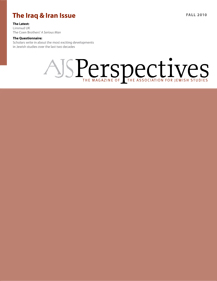Dear Colleagues,
After a period of seven years, AJS is returning to Boston for its forty-second annual conference. Longtime members often speak wistfully of AJS's early meetings at the Copley Plaza, just across the street from where this year's meeting will be held. In 1996, when the AJS conference last convened at the Plaza, the conference had seventy-eight sessions; this year, the number has more than doubled, a reflection of the expansion of the field, the growth of the society, and the popularity of Boston as a venue. (More than onethird of AJS members are from the Northeast.) Indeed, this year AJS received the highest number of submissions in its history: 157 session submissions and 288 individual paper submissions, compared to 117 and 272 submissions, respectively, in 2009.
While this growth is certainly good news—especially in an economic climate where all we seem to hear about is contraction—it is not without its challenges. To significantly increase the number of papers accepted would transform the conference's culture, a culture that distinguishes the AJS meeting from the larger, disciplinary gatherings. "Record submissions" represent the vitality of the field, the health of the organization, and the value of the conference, but they also produce a good deal of hand-wringing among the AJS board and conference program committee, which have to balance two, somewhat contradictory goals: one, to offer a wide platform for new research and give members ample opportunity to share their scholarship, get feedback, and secure travel funding (often contingent on presenting a paper); and, two, to organize a conference that retains a certain intimacy, does not dilute audiences by too many simultaneous sessions, and only accepts the most outstanding proposals.
AJS sought a middle path in response to the unprecedented number of submissions this year: we added a new time slot (Tuesday, 3:45–5:45 pm) which will accommodate several additional sessions. We also expanded the poster session to include digital media presentations, as well as created a new, fifteenth-session time slot for digital and media-oriented panels. But AJS also increased the overall rejection rate from approximately 20 percent in 2009 to 30 percent. This is well within the range of rejection rates of other learned societies, several of which approach 50 and 60 percent for especially popular locations. Still, the greater number of rejection letters going out this year caused some consternation among scholars who have presented at the conference for years, as well as among those applying—and being rejected— for the first time.
The evaluation criteria for proposals include originality of research, methodology, contribution to the field, and clarity of argument. The twenty division chairs score abstracts according to these criteria, rank created and pre-formed sessions, and pass their acceptance/rejection recommendations on to the program committee. It is then the program committee's task to review all of the division chairs' recommendations and create a high-level and diverse conference program that will appeal to the wide-ranging interests of AJS members. This is not to say that all very strong proposals make it into the final schedule—some individual proposals regarded highly by both division chairs and the program committee are rejected simply because there is no appropriate place for them in a session. The rejection rate of individual proposals is in fact a good deal higher than that of pre-formed sessions. We recognize that some scholars are new to the field or not tapped into a network to build a panel. In these cases, we suggest these scholars submit a proposal according to one of the division chair's suggested themes, or else use the Sessions Seeking Participants page on the AJS website.
We've added several other new features to this year's meeting, including a Monday afternoon time slot for more informal, professionally oriented discussions and times to meet with the AJS division chairs and publication editors to discuss the state of the field and suggestions for the organization. As always, please feel free to e-mail your thoughts and comments any time of the year to the AJS office at ajs@ajs.cjh.org. I look forward to seeing you in December.
Rona Sheramy
Association for Jewish Studies

